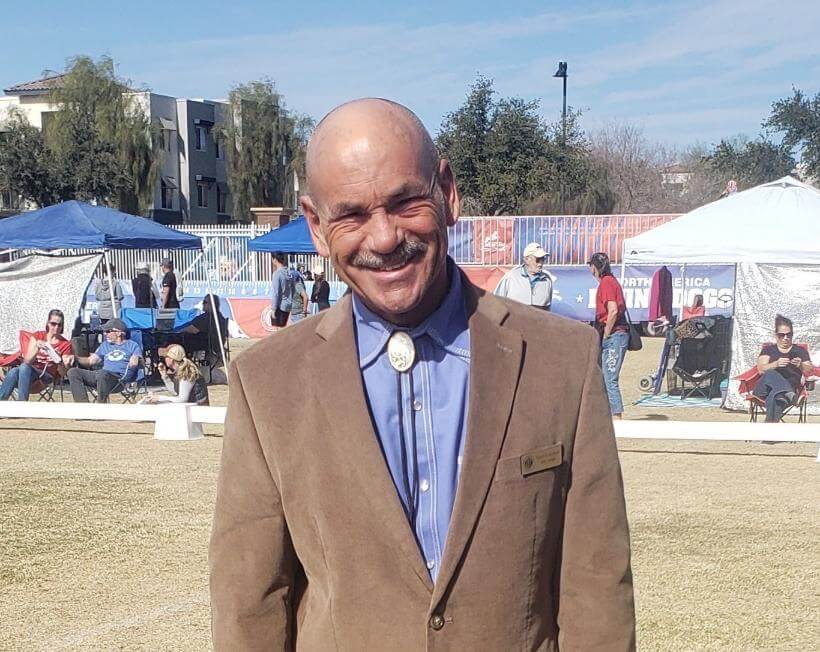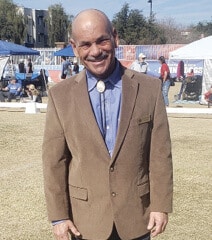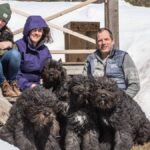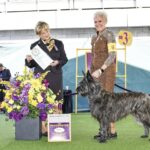Interview with Herding Group Judge Harry Schulman
Where do I live? How many years in dogs? How many years as a judge?
Harry Schulman: I live in my hometown of Louisville, Kentucky, with my wife, Robin, and Golden Retriever, “Maui.” I am a third-generation dog man. My mother was an AKC licensed judge. I have been involved in the sport of purebred dogs for 53 years. I started handling in Junior Showmanship and in the breed ring when I was nine years old. I handled my parents’ Collie bitch to Best of Opposite Sex at the 1972 Collie Club of America National Specialty when I was 12 years old. That is when I was bitten by the Dog Show Bug. I have been a judge since 2006.
What is my original breed? What is/was my kennel name?
Harry Schulman: My original breed is the Collie and my second breed is the Doberman Pinscher, which I also dearly love. I have bred, and continue to occasionally breed, Collies under the Strathmoor prefix.
Can I list a few of the notable dogs I’ve bred? Any performance or parent club titles?
Harry Schulman: Ch. Strathmoor Sir William Wallace (National Specialty winner), Ch. Strathmoor Sacred Ground, and Ch. Strathmoor A Fantasy Shared are a few of my notable Collies. Two of my favorite Collie bitches, the incomparable Strathmoor Stand On A Star and Strathmoor Madame Butterfly, took a back seat to funding my children’s education and never finished, but in my view they exuded true breed type and were the best dogs I ever bred. Now as a judge, I co-breed litters on occasion with my dear friend, Sue Wyglendowski of Karachristo Collies, who has my Strathmoor lineage entrenched in her breeding program.
What are the qualities I most admire in the Herding breeds?
Harry Schulman: Herding breeds are instinctive, athletic, industrious, agile, and intelligent. When my kids were little, I would love to sit on the deck and watch my Collies herd them around the back of my property. Most of all, Herding breeds are loyal to their family members and have tremendous heart. A Collie’s expression is the hallmark characteristic of the breed and is essential for correct breed type. True Collie expression should be a window to the dog’s soul and there is nothing more genuine and pure than the love and devotion of a Collie’s heart and soul.
Have I judged any Herding Group Specialties?
Harry Schulman: I have been honored to judge multiple National and Regional Specialties in the Herding Group. I judged the 2021 Old English Sheepdog Club of America National Specialty, the 2019 Collie Club of America National Specialty, the 2018 American Bouvier des Flandres Club Regional Specialty, the 2017 Canaan Dog Club of America National Specialty, the 2017 Berger Picard Club of America National Specialty, the 2013 Collie Club of Japan National Specialty, the 2013 Shetland Sheepdog Club of Japan National Specialty, and many other independent specialty shows for an array of Herding breeds from coast to coast. Recently, I was selected to judge the 2023 Puli Club of America National Specialty. It was a real thrill for me to live to see the young bitch, Ch. Tokyo Jazz JP Champagne Showers, that I selected to win the Breed equivalent at the Collie Club of Japan National Specialty, become the first Japanese-bred dog to also win the Breed at the Collie Club of America National Specialty three years later.
Do I find that size, proportion, and substance are correct in most Herding breeds?
Harry Schulman: Size, proportion, and substance are correct in most Herding breeds; however, I would like to see more consistency in size within the standard for the Miniature American Shepherd.
Is breed-specific presentation important to me as a judge? Can I offer some examples?
Harry Schulman: It depends upon how you define “breed-specific presentation.” The German Shepherd Dog presents in a three-point stance for balance and it should be an anatomically natural stance for that breed. In fact, the German Shepherd Dog should walk into his stance no differently than a Collie should stop four-square. Some breeds are sculpted far too much, which detracts from a breed-specific presentation, but the hands and the eye do not lie; so a good judge can distinguish between the structure and the artistry. I like to see my Old English Sheepdogs walk, to watch them amble before I assess their down and back and go-around in a free, powerful, and seemingly effortless trot. The definition of a breed-specific presentation may vary from judge to judge, but it should always convey correct breed type immediately at first sight.
What about breed-specific movement? Do I demand this from Herding Dogs?
Harry Schulman: Absolutely, I demand breed-specific movement from our Herding Dogs. For example, a Briard must have quicksilver movement that allows him to turn on a dime, be the first out of the starting gate, so to speak, and come to a sudden stop. His leg construction is of utmost importance because it facilitates his ability to work and his resistance to fatigue. Sufficient leg length also enables him to see over the invisible fence line around the flock. Likewise, the Australian Shepherd must be agile enough to change direction and alter his gait instantly in order to do his job. To me, there is not anything more breathtaking in the canine world than a German Shepherd Dog with an exquisite flying trot moving in “the steady motion of a well-lubricated machine.” I value the virtue of exceptional movement in our Herding Dogs, but in the Collie there is nothing, and I mean nothing, that should take precedence over detail of head and a stunning expression. As the standard clearly states, “The Collie cannot be judged properly until its expression has been carefully evaluated.” Collies do need to have correct balance and structure to do the job they were bred to do, but the head and expression sets the Collie apart from the other Herding breeds, and movement should not be the primary determination.
Are the Herding breeds in good shape overall? Any concerns?
Harry Schulman: I fervently believe the Herding Group is typically one of the most competitive Groups at any dog show. I have seen wonderful quality in multiple Herding breeds lately, specifically some of the breeds that get overlooked in the Group ring like our Belgian Sheepdogs, Belgian Tervurens, Finnish Lapphunds, Norwegian Buhunds, Icelandic Sheepdogs, Beaucerons, Polish Lowland Sheepdogs, Canaan Dogs, and Berger Picards.
In my opinion, how do today’s exhibits compare with the Herding Dogs of the past?
Harry Schulman: It depends upon the breed and how long you’ve been around in our sport. Many dogs of the past could still compete with our top dogs of today. Some of the dogs that come to mind are my two favorite German Shepherd Dog bitches, Ch. Altana’s Mystique and Ch. Jerrwin’s Madison Avenue; the Old English Sheepdog bitch, Ch. Rholenwood’s Taylor Maid; the Belgian Tervuren dog, Am./Can./Mex. Ch. Mars de Fauve Charbonne UDT (handled by my beloved mentor, Charlie Cooper), and of course, the Shetland Sheepdog, Ch. Halstors Peter Pumpkin, as well as a Shetland Sheepdog bitch that made my heart skip a beat, Ch. Macdega Apropos (bred and owned by Nioma and Tom Coen). I would be remiss if I did not mention several Collies that could also compete with the best in my breed in the ring today, namely, Ch. Black Hawk of Kasan, Ch. Larkspur On Eagles Wings, Ch. Tartanside Arabesque, and Ch. Wickmere Rapunzel. Many of the great dogs of today go back to the great dogs of yesteryear. As breeder icon, Elisabeth Browning of Tokalon Collies frequently said, “The purest water is at the well.”
Why do I think Herding Dogs can often become outstanding Show Dogs?
Harry Schulman: Many dog breeds can become outstanding Show Dogs as all good dogs look alike. Our Herding breeds have an exuberant zest for life that is just as apparent in the show ring as it is in the jobs they do to serve mankind, so the great ones really stand out.
Just for laughs, do I have a funny story that I can share about my experiences judging the Herding Group?
Harry Schulman: I was used to wearing my formal military Mess Dress for 23 years in the U.S. Air Force and I had not had on a regular tuxedo since my high school senior prom. I was required to wear a tuxedo when I judged the Herding Group at the National Dog Show in Philadelphia in 2017 that was televised on Thanksgiving Day. I went with my wife, Robin, to rent a tuxedo and she made sure that it fit perfectly for this special event. Her famous last words were, “Honey, this is not like your military Mess Dress that was tailored for you, so be sure you tighten the sides of your pants when you change into it before you judge.” Flash forward. The National Dog Show was filmed two weeks before Thanksgiving for edits, and I happened to be judging that Thanksgiving weekend in Montgomery, Alabama, while my entire family watched me judge the Herding Group in Philadelphia on Thanksgiving Day. My two daughters were the first to notice, when they asked my wife, “Mom, why does it appear that Dad’s tuxedo pants are dragging the ground on national TV and why does he keep tugging on them to pull them up? Did you not fit him properly?” My two sons thought it was simply hysterical. And, of course, my wife said, “OMG, he forgot to hook the sides. That man just never listens to me.” Every Thanksgiving, my family replays that Herding Group assignment just for laughs. It is now a family tradition. You can rest assured that if I am ever fortunate enough to be invited back to Philadelphia to judge the National Dog Show again, I will not forget to hook the sides of my tuxedo pants!
Our Herding breeds have an exuberant zest for life that is just as apparent in the show ring as it is in the jobs they do to serve mankind, so the great ones really stand out.










